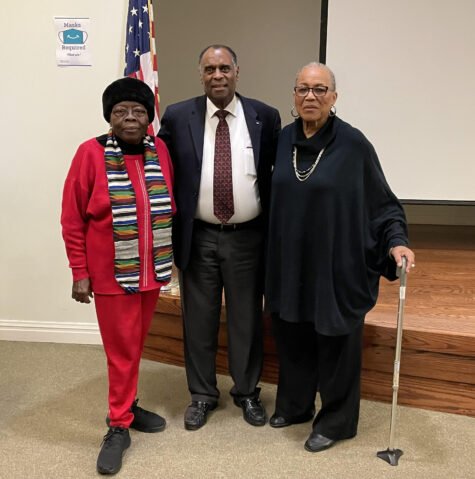
Attendees were recently treated to a lively panel discussion at Bay Shore-Brightwaters Public Library as part Bay Shore Historical Society’s commemoration of Black History Month.“Are We There Yet? A Short Trip, but a Long Journey Through Bay Shore’s Black Community” was a discussion led by a distinguished trio of respected Bay Shore locals, including Mary Holmes Reid, a mother and activist; James Cornigans, a father, social studies teacher at Bay Shore High School, and deacon at the First Baptist Church of Bay Shore; and Deanna Watts, a mother, writer, activist, and public speaker. Through time, research, and interviews the panel demonstrated how much Bay Shore means to them.Cornigans spoke candidly about the trials, tribulations, and triumphs of Black life in the town. “It was a long and narrow confined area of Bay Shore,” he reminisced in describing the neighborhood where Black populations and Native Americans lived alongside one another. “Harrison Avenue, Harrison Place, and Brooke Street by the railroad to the south of Sunrise Highway, which was then called The Boulevard.”Deacon Cornigans also spoke about how First Baptist Church of Bay Shore had its humble beginnings in 1918 where “a rented tent raised in an open field became the first meeting place,” he said. “The dedicated early Black pioneers of this church worked tirelessly to help the growth of the congregation. They set up businesses, such as taking in laundry, working as laborers, doing masonry work, being midwives, sewing clothes, selling fruit that was raised in their gardens, and raising chickens … it wasn’t always safe to do this work either as many of these people were not supposed to go outside of that little area.”Reid addressed the audience with her own recollections. “My mom, as I’m told, came here because she thought that money grew on trees,” she said. “Well, there was no money hanging from the trees. But what we did find out is that most of us came here in search of a better life, and most of us found something probably better than what we had.” When Watts took her turn at the helm, she smiled as she reminisced about her teen years and the socials that would take place in neighborhood homes, where a parent would sit at the front door and collect 25 cents per person. “There was lots of dancing. No alcohol allowed, but there was food, and we drank Kool-Aid – lots of Kool-Aid!”Watts explained adults at that time also frequented a place called Johnny White’s. It was a vibrant place where many of the greatest musicians of the times, such as Bo Diddley, played. With so many people going there, it was also the site where major community decisions were made. Interestingly, it was never legally licensed. It’s believed that since its existence kept the Black community on the north side of Union Boulevard, the authorities never bothered the owner.Another positive force in Watts’s young life was Eliza Hamilton, who was the president of the National Council of Negro Women, a group that Watts and other young women in the community joined. Hamilton took the group of young Black women on annual trips to Washington D.C. to attend the National Council meetings. “For the first time we saw Black women who were in leadership positions,” said Watts. “These women were teachers, they were doctors, lawyers, and we learned how to run meetings.”On a sadder note, Watts also shared memories of a devastating loss to the community when young Norman Alfred Wood joined the U.S. Marines, never to return home as a result of the tragic event that gained national attention known as the Ribbon Creek Incident.“It was a horrific loss … all he ever wanted to do was serve our country. Sadly, he succumbed to drowning off of Parris Island at only 17 years old.”The contributions of Black Bay Shore residents has been significant, including creating a branch of the NAACP and staging a sit-in at Woolworth’s in the 1960s.“This has been a long journey for me,” Watts continued. “This is a multicultural community. Bay Shore residents banded together and challenged the Klu Klux Klan, who marched and burned at least one cross. Unfortunately, this summer, the Proud Boys paraded through our downtown on a lovely, crowded Saturday evening. Why did they think Bay Shore is a town that would tolerate such hateful behavior? This sure may not be the mountaintop described by Dr. King, but it is a richer, more vibrant, and more inclusive place than when we began our journey.”































